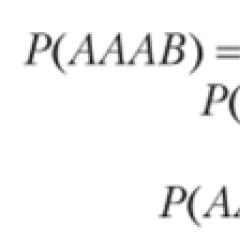Which is better secondary housing or a new building. What is the primary housing market
Buying an apartment is not an easy question, and the first thing that all future newcomers think about is to take an apartment in the primary or secondary market? the site has analyzed the merits and demerits of both options to help readers make a choice.
"Secondary": pluses
1. The apartment is already there... Buying a second home, you already get it. There is no risk to buy meters that will never be built due to the bankruptcy of the developer, the economic crisis or other problems. In addition, it is already possible to move into the apartment - you do not have to spend money on a rented apartment, while waiting for the completion of construction. This is especially important for those taking out a mortgage.
2. Inhabited place. An apartment on the secondary market has an undeniable advantage - it is already a habitable place. You will immediately see the state of the entrance and how the management company is monitoring the yard. You can talk to neighbors before buying, find out the rating of the nearest school and find out all the details about the area.
3. You don't have to live at a construction site. New housing, even rented out with finishing, suggests that neighbors can redo renovations, or bring in furniture, or simply drill the walls to hang shelves. If the entire entrance does this, it will be impossible to live in the house for the first year or two.
4. There are no empty apartments. In a new building, very often neighboring apartments may be empty, especially if their owners do not have the opportunity to make repairs or they bought housing for investment purposes. This means that in such entrances, the likelihood of robbery and theft is higher - thieves love quiet and empty places. In addition, it is simply uncomfortable to live in a house where half of the apartments are not inhabited.
5. You can choose a familiar area. When buying an apartment on the secondary market, you can choose an area that you like with its location or just convenient because your relatives live here or your childhood passed.
6. Renowned construction quality. There are fewer surprises in the housing of the secondary market - we all know how the "stalinkas", "Khrushchevs" and "panels" of the 70s and 80s were designed and built. These are strictly observed construction standards, albeit rather modest ones. In the market for new buildings, surprises in the form of missing ventilation or uncovered holes under the windows are not excluded (alas, this happens).
7. You can immediately register. An apartment on the secondary market is a full-fledged housing immediately after the conclusion of the transaction. When buying a new building, you will have to wait a fair amount of time until the ownership is established properly.
8. Classical layout of small apartments. Old Soviet housing, no matter how scolded it, is to a certain extent convenient and functionally thought out for the economy class level. In modern buildings, there are apartments of a larger area, but less comfortable for life (for example, the corridor can be large, and the room is smaller than the kitchen, or, if we talk about small studios, they are often made like a carriage).
Disadvantages:
- old communications, small areas of apartments, more expensive per square meter, unfree planning, housing with a "history" (including bad) and unclean deals with the sale of an apartment with registered tenants are possible, etc.
"Primary": pluses
1. For less money, you can buy a house with a larger area. The main plus of the "primary", which is called by all, without exception, buyers. On average, the difference in the cost of housing under construction and finished housing of comparable parameters and location can reach 15-30%. It is especially convenient to buy apartments in the early stages of building a house.
2. Modern construction, new communications. If the developer is responsible and builds the house conscientiously, then the new building will never have the problems known to the residents of old houses - endless leaks, crumbling plaster in the entrance, a facade “bald” from the rains or a leaky roof.
3. Free layout. Many new buildings, especially business-class ones, presuppose free planning of the apartment premises, which makes housing more convenient for oneself.
4. Legal transparency. If the developer is respected and reliable, then there will be no problems with buying an apartment. This is a guarantee that no one will be registered in the apartment or that there will be no other applicant from among the seller's relatives.
5. The level of comfort. Modern houses they are usually built with spacious lobbies, convenient elevators and entrances, with additional commercial premises on the ground floor and infrastructure such as bike paths or a private park.
6. Unified environment, complex construction. For lovers of novelty, buying an apartment in a new building is a real joy: everything will be new here, especially when it comes to a comprehensive urban planning solution. In fact, you are moving to a new city. This will also appeal to those who believe that the energy of past tenants may not have the best effect on new settlers - and therefore strive to settle in a house where no one has lived before.
7. Mortgages. It is much easier to get a mortgage loan for a new building than for a secondary housing. True, at first the interest rate on a loan for an apartment in the secondary market will be 1-1.5% less than for an apartment in a new building. However, after registration of property rights, mortgage rates are compared for properties in the primary and secondary markets. Nevertheless, a mortgage on a new building requires less red tape - as a rule, a developer or an official realtor company has a mortgage broker right at the company's office.
8. Investment attractiveness. An apartment on the primary market also has an advantage in the rate of growth in value, which makes its acquisition attractive for investment. Depending on the object, the price increase from the start of construction to the commissioning of the object can reach 30%, and sometimes even more under the influence of external factors, such as the construction of the metro and the addition of new territories in Moscow. For example, having bought a one-room apartment with an area of 45 square meters in the Butovskie Alley residential complex in a building at the excavation stage for 2.8 million rubles, in a year the investors were able to realize such an object for 5 million rubles, the website of the analysts of the Est-a- company reported. tet.
Disadvantages:
- possibly higher cost of housing and communal services, for some time you will have to live at the "construction site", there is a danger of becoming a deceived shareholder, you will have to wait a long time until the area acquires a habitable look.
Primary housing is a dwelling that acts as a commodity for the first time. In other words, these are apartments and houses for which the right of ownership has not yet been established. Construction companies or the state act as sellers in the primary housing market.
Primary housing is acquired either with participation in shared construction in the process of building a house, or in finished new buildings with apartments that are not registered in the state register of property. Moreover, the cost per square meter is minimal at the first stages of construction and increases as it is completed.
Speaking about the feasibility of purchasing housing in the primary market, it is necessary to take into account the construction time, subsequent investment in the improvement of new housing and the degree of risk of participation in shared construction.
Buying a primary home makes sense in the event that questions about the place of residence or registration are not acute and may take several years until construction is completed.
It should be borne in mind that upon commissioning of housing from equity participation, you will have to repair from scratch. On the one hand, you will not have to redo anything in the apartment after the previous tenants and the finishing will fully meet your requirements and desires. On the other hand, you need to be prepared for additional considerable spending of money and time.
In general, equity participation, in spite of the legal "purity" of the primary housing, is a risky undertaking. In the long time frame of construction, it is difficult to predict the specific timing of the completion of construction, the possibility of bankruptcy of the developer or the occurrence of economic and social changes in the country. However, under a favorable set of circumstances, buying a home on the primary real estate market is profitable.
Secondary housing
Secondary housing is an apartment or house that is already someone's property. This is not just about new and old houses: primary housing becomes secondary from the moment of obtaining a certificate of state registration... If the developer, for some reason, does not sell the apartment before the completion of construction and formalizes the ownership of himself for the purpose of its further sale, this apartment will already have the status of secondary housing. In addition to developers and the state, private individuals are also sellers in the secondary market.
When compared with the primary, secondary housing is more expensive for the buyer. But the risks associated with the purchase of such an apartment are minimal. They can only be associated with the termination of the purchase and sale agreement or with the presentation of rights to the apartment by third parties after its purchase. With a competent legal approach to the acquisition of housing, such risks are excluded.
If there is a need to urgently move to the apartment being purchased, then you should buy a living space on the secondary market. The same applies to registration, since it is possible to register in an apartment only in a finished room and in the presence of a certificate of state registration.
Currently, there are enough offers on the real estate market. In addition, it is developing mortgage credit lending, the rates on which, after a short-term increase due to the crisis at the end of 2014, began to decline. And now (mid-2015), thanks to state support, the mortgage interest is in the range from 11 to 14. All this increases the chances of people to buy exactly the apartment they have dreamed of for so long.
But in the apartment market, as you know, there are two types of proposals - apartments of the primary and secondary construction fund... Therefore, for many, the "cornerstone" is not the location of the house or even the area of the apartment, but what fund will be purchased housing.
This question is not easy. For this reason, it is not uncommon for future owners to look for an answer to it on the Internet. This article is just one of the many pages of the world network, which help everyone to decide what is for him better: "primary" or "secondary"... Here's how these two concepts differ from each other. And also what are the advantages and disadvantages of the primary and secondary fund.
Primary fund
"Primary housing" is a housing that does not have and did not have an owner. In fact, these are apartments and rooms in new buildings. Moreover, even in those cases when at the time of purchase they are presented only on paper (in the project documentation).
Regulates the sale of primary stock apartments the federal law No. 214 "On participation in shared construction". It is he who determines the rights and obligations of the developer and the shareholder. So, according to him, the developer company after commissioning apartment building undertakes to transfer the object of shared construction to the buyer. In turn, the purchaser of an apartment in a new building must register the resulting title to it. After that, the "primary" turns into a "secondary".
In the event that not all apartments are at the time of delivery of the state. were sold out to the authorities, the developer is obliged to register ownership of them himself, and then sell them as secondary housing.
Pros of the "primary":
- "Novye"- a clean house with clean entrances and lifts. There are no extraneous smells and energy of the previous tenants.
- Convenience- Currently, construction technologies have stepped forward several steps. And now modern house much more convenient than those that were built 20 years ago. So, for disabled people in new buildings, a ramp or lift is provided, vestibules and elevators are increased (quite often the main elevator is duplicated by the freight one). In addition, it is not uncommon for stairwells to provide space for strollers.
- Free layouts- in primary housing there is a category of houses with apartments, where a free layout. That is, the owners here have the right to choose the place of installation of the partitions themselves or completely abandon them.
- Profitability- As you know, the cost of an apartment from the moment of the opening of sales to the date of commissioning increases from 30 to 100%. Therefore, by buying an apartment at the project stage, you can save a lot or earn money.
Cons of the "primary":
- Big risk- buying an apartment in a new building is associated with a greater risk than purchasing a secondary fund. So, in the event of a developer's bankruptcy, it is unlikely that real estate investors will be able to get their hard-earned money. Indeed, today there is no law that would fully protect them.
- Lack of decoration- quite often the “lucky ones” move into an apartment, where a pleasant grayness of concrete walls, ceiling and floor or a fascinating drawing awaits them from the decoration brickwork... Therefore, before you start living with pleasure, you will have to invest a lot of effort and money in your “square meters”. And often more than in the case of the "secondary housing". For the sake of fairness, it is worth noting here that they usually try to transfer housing of "economy class" to a shareholder with already made minimal repairs.
- Reducing an advantageous offer- as the house grows, not only the price of living space rises, but also the number of inexpensive and liquid apartments decreases. In this regard, by the time the house is put into operation, only apartments of a large area or with any drawbacks (for example, a bad view from the window or a pumping station under the kitchen) may remain.
- Lack of registration- while the house is being built, it is impossible to register in the apartment, since the buyer does not have a certificate of state registration of ownership.
Secondary fund
Secondary fund - these are apartments that already have an owner. Moreover, property can be both private and state. In the latter case, people occupy living space under a social tenancy agreement.
Pros of the "secondary housing":
- Less risks- the conflict between the buyer and the seller of the apartment is resolved in court, if it is not possible to terminate the contract of sale amicably. In this case, the court most often obliges to return to each of the parties what it received under the contract. But more elaborate legislation in this area does not mean that the buyer is completely protected from fraud. Sometimes it happens that the seller hides all the persons registered in this apartment. Well, the most common deception here is the overpricing after the realtor receives an advance payment.
- Apartment ownership- here the buyer gets the apartment almost immediately into the ownership, in which he can subsequently register without delay.
- Better mortgage- for the purchase of an apartment in the secondary fund, the mortgage is issued at lower rates (sometimes lower than for the "primary" by 1-2%). Moreover, the number of banks that can do this is much greater. It is no secret that a developer is usually accredited by no more than two banks.
Cons of "secondary housing":
- High price- the secondary housing stock under similar conditions is more expensive than the primary one.
- Old building codes- the predominant offer here is apartments in houses built in the times Soviet Union in 60-80 years. And these apartments are no different large area and the convenience of layouts. Not to mention the fact that there may be no or no elevators in the entrances.
- Second master- already lived in the apartment. This means that the smells of the previous owners are possible. Especially if the "highlanders" lived in this apartment. In addition, the future owners may not be satisfied with the repairs that were made before them. Fixing all of this will incur unnecessary costs. True, in all fairness, it should be noted that the costs here are often lower than during repairs in the "bare primary".
- Unpredictable neighbors- in the case of the "secondary", the probability of running into some "grandmother-Gestapo" is much greater than with the "primary". Indeed, in new buildings, as a rule, people between the ages of 25 and 45 buy apartments with a certain level of income.



